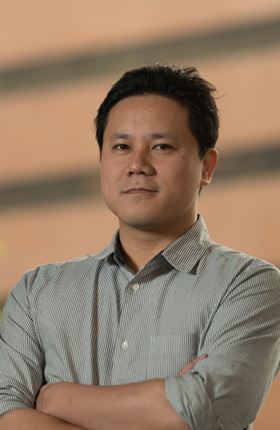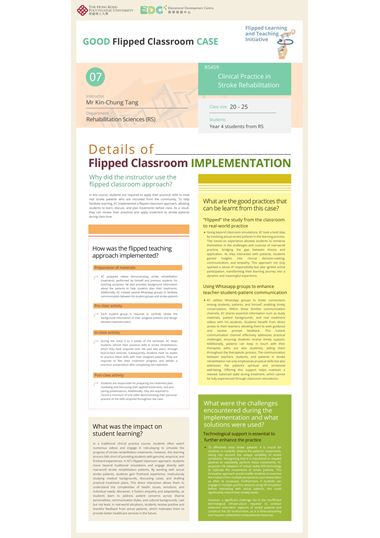
General Information
- Instructor: Mr Kin-Chung TANG
- Department: Rehabilitation Sciences
- Subject: RS459 Clinical Practice in Stroke Rehabilitation
- Class size: 20 - 25
- Students: Year 4 students from RS
Why Use the Flipped Classroom Approach?
Implementation Steps
KC prepared videos demonstrating stroke rehabilitation treatments, performed by himself and previous students for teaching purposes. He also provided background information about the patients to help students plan their treatments. Additionally, KC created several WhatsApp groups to facilitate communication between his student groups and stroke patients.
Pre-class activity
Each student group is required to carefully review the background information of their assigned patients and design detailed treatment plans.
In-class activity
During the initial 3 to 4 weeks of the semester, KC helps students refresh their practical skills in stroke rehabilitation, which they have acquired over the past two years, through face-to-face tutorials. Subsequently, students have six weeks to practice these skills with their assigned patients. They are required to film their treatment progress and deliver a one-hour presentation after completing the treatment.
Post-class activity
Students are responsible for preparing the treatment plan, reviewing and discussing their applied treatments, and preparing presentations. Additionally, they are required to record a minimum of one video demonstrating their personal practice of the skills acquired throughout the class.
What Impact Did This Have on Student Learning?
What Are the Good Practices That Can Be Learnt from This Case?
Going beyond classroom simulations, KC took a bold step by involving actual stroke patients in the learning process. This hands-on experience allowed students to immerse themselves in the challenges and nuances of real-world practice, bridging the gap between theory and application. As they interacted with patients, students gained insights into clinical decision-making, communication, and empathy. This approach not only sparked a sense of responsibility but also ignited active participation, transforming their learning journey into a dynamic and meaningful experience.
Using Whtasapp groups to enhance teacher-student-patient communication
KC utilises WhatsApp groups to foster connections among students, patients, and himself, enabling timely conversations. Within these familiar communication channels, KC shares essential information such as study materials, patient backgrounds, and real treatment videos with his students. Students benefit from direct access to their teachers, allowing them to seek guidance and receive prompt feedback. This instant communication channel effectively addresses practical challenges, ensuring students receive timely support. Additionally, patients can keep in touch with their therapists (who are also students), aiding them throughout the therapeutic process. The communication between teachers, students, and patients in stroke rehabilitation not only emphasises practical skills but also addresses the patient’s spiritual and emotional well-being. Offering this support helps maintain a relaxed, balanced state during treatment, which cannot be fully experienced through classroom simulations.
What Were the Challenges Encountered During the Implementation and What Solutions Were Used?
To effectively treat stroke patients, it is crucial for students to carefully observe the patients’ movements, taking into account the unique variability of stroke symptoms. Recognising that it is impractical to request patients to repeatedly perform these movements, KC proposes the adoption of virtual reality (VR) technology to replicate the movements of stroke patients. This innovative approach would enable students to examine the motions from multiple perspectives and review them as often as necessary. Furthermore, if students can engage in multiple practice sessions using VR simulation before interacting with actual patients, this could significantly reduce their anxiety levels.
However, a significant challenge lies in the insufficient technological infrastructure required to conduct extensive volumetric captures of stroke patients and construct the 3D environment, as it is time-consuming and requires substantial computational resources.

